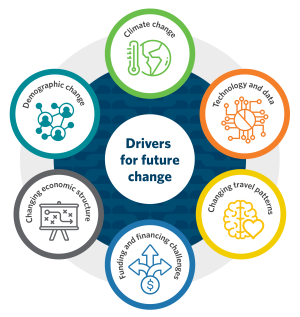
There are six key external factors, or drivers, that will shape and change the future land transport system:
The Strategic context of Arataki has full guidance on this topic, as well as information about what the land transport system will look like in 30 years, plus challenges and opportunities for transport outcomes.
Arataki September 2023 v1.1 updates the March 2023 release of the Strategic context to reflect the severe weather events of 2023 and make minor corrections.
Arataki strategic context [PDF, 5.4 MB]
Population growth is a fundamental driver of our transport challenges and opportunities. A growing population means more people who need to get to places that matter to them like work, education, and entertainment. It also means more goods need to be moved to these growing locations.
While COVID-19 has affected population growth patterns, long-term growth is expected in urban areas, particularly in the Upper North Island.
The population of Aotearoa New Zealand is ageing because of declining birth rates and better healthcare. In some areas, people aged over 65 are expected to make up over 35% of the population.
The economy is shaped by, and shapes, our land transport system.
The trend towards a service industry-based economy is leading to greater urbanisation, more intense urban development, and increased transport demand.
Certain communities in urban centres face challenges of social deprivation such as:
Climate change is already impacting the land transport system and will continue to do so for decades to come. The country’s greenhouse gases have increased by 24% in the last two decades and 20% is because of transport.
Building, maintaining, and operating the land transport system uses large quantities of fossil fuels and virgin materials, such as aggregate and other resources. This means high levels of carbon in the land transport system. We need to look for ways to reduce carbon emissions when maintaining operations and use lower-carbon materials where possible.
Arataki – Climate change impacts on New Zealand [PDF, 412 KB]
Technological advances are changing how the transport system is used and managed. These changes are happening rapidly and increasingly disrupt the way we use and manage the system.
How we regulate and manage access to the network through new platforms, services, and providers is changing. New technology is allowing risk-based and intelligence-led regulation. This may lessen compliance costs for regulators and system users.
It’s getting more expensive for central and local government to pay for critical activities like maintaining and renewing infrastructure assets and managing the impacts of climate change.
Significant change is required. We will need to be supported by the right investment.
Investment must be prioritised to deliver the most effective, long-term solutions to move people, goods, and freight. Increased capital costs, such as those used to manage the effects of climate change, will impact the amount of funding available for the land transport system.
Growing consumer expectation for more and faster deliveries is expected to:
During the COVID-19 pandemic, public transport use decreased significantly as businesses encouraged flexible-working arrangements. As the country recovers from the pandemic, these new patterns seem are here to stay.
Other shifts in travel patterns are happening and are expected to continue over time.